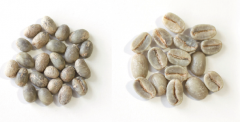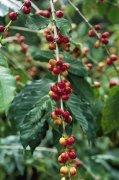Characteristics and attributes of coffee from eight major producing areas of Guatemala
Ekataru Valley
Up to 2000 meters (6500 feet) above sea level, with dense shade and unique ecology, the nearby Fuego volcano erupts, making its coarse, sandy soil rich in a variety of minerals. Temperate sea breezes from the Pacific and a seasonal climate allow coffee in this region to be dried by sunlight and processed according to traditional family methods that have been accumulated over the years.
[characteristics] the acidity is obvious, the dry and wet fragrance is remarkable and pleasant, the alcohol thickness is good, and the aftertaste is clear and long.
Koban of Rainforest
It is cloudy and rainy all the year round and the climate is cool. The vast majority of Koban coffee in the rainforest is grown in the obviously undulating and foggy mountains of the region and is deeply influenced by limestone and clay in the Atlantic basin. Koban has two seasons: the rainy season and the rainy season.
[characteristics] obvious fresh fruit flavor, balanced mellow thickness, pleasant aroma.
Antigua
Rich volcanic soil, low humidity, plenty of sunshine and cool nights are the characteristics of this producing area. The valley is surrounded by three volcanoes: Agua, Fuego and Acatenango. Volcanic ash from the eruption makes the soil of Antigua rich in minerals. Volcanic pumice can maintain humidity and overcome the lack of rainfall in Antigua; dense tree shade protects against occasional frosts.
[features] Wet fragrance is rich, balance is good, sweetness is high, taste is elegant.
Tiny Nanguo Highland
Of the three major non-volcanic coffee-producing regions in Guatemala, the Weitango Highlands has the driest climate and the highest elevation. The dry and hot wind from Mexico's Tehuantepec plateau protects the coffee from frost and can be grown to 2000 meters (6500 feet). Because of its remote location, all coffee farmers have to process their own coffee. Fortunately, there are so many streams in the area that small processing plants can be set up almost anywhere.
[characteristics] High acidity, pleasant, high alcohol thickness and wine aftertaste.
Waiqiangsi plateau
The area is of volcanic soil, with high altitude, sufficient rainfall and great humidity variation. Ash from Pacaya, Guatemala's most active volcano, provides important minerals for the soil in the region. There is plenty of sunshine in the dry season, and although the clouds and dew are heavy in the morning, they dissipate quickly. As a result, 100% of the coffee in the area is processed in the full sun.
[characteristics] the acidity is bright and consistent, the aroma is sufficient, and the thickness of alcohol is delicate.
New Oriental
Coffee in this area has been grown entirely by small farmers since the 1950s, and now every farmer in the mountains is a coffee production unit. This area, once the most remote and poorest part of Guatemala, is now alive and well. Rainy, cloudy, New Oriental ancient times is a volcanic area, soil volcanic metamorphic rock evolved, rich in minerals, balanced nutrition, different from other volcanic coffee producing areas.
[features] the palate is well-balanced, mellow and full-bodied, with chocolate flavor.
Traditional Atitlan
Atitlan is one of the five largest volcanic coffee producing areas in Guatemala, and its soil organic matter is the most abundant among the five volcanic coffee producing areas. 90% of the traditional Atilan coffee is grown on the violent volcanic slopes of Lake Attila, where the daily breeze stirs the lake, which is an important factor affecting the microclimate of the region. The area has accumulated excellent planting and processing techniques for a long time.
[characteristics] the aroma is refreshing, the acidity is bright and the mellow thickness is full.
San Marco, vol.
San Marco has the hottest climate of the eight largest coffee producing regions in Guatemala, with a maximum rainfall of 200inches (5000 mm). The rainy season is earlier than in other areas, and coffee trees bloom earlier. Like other remote areas of Guatemala, volcanic San Marco coffee is grown and processed by small farmers. Due to frequent rainfall in the rainy season, most coffees are pre-dried in the sun and then dried in a Guardiola dryer.
[characteristics] there are subtle floral aromas in the aroma and taste, obvious acidity and good mellow thickness.
Important Notice :
前街咖啡 FrontStreet Coffee has moved to new addredd:
FrontStreet Coffee Address: 315,Donghua East Road,GuangZhou
Tel:020 38364473
- Prev

Basic knowledge of boutique coffee beans do coffee beans divide male and female?
If you are interested in Baidu, you will see some articles describing the separation of male and female coffee beans, and mention that the flavor of male beans is better than that of mother beans. In fact, as a hermaphroditic, self-pollinating plant, there is no distinction between male and female in the seeds of coffee trees. In a normal fresh coffee fruit, the spherical coffee seed is composed of two coffee beans together, the plane is relatively inward, and the arc is outward.
- Next

Chinese boutique coffee bean variety Yunnan coffee variety
Typica and Bourbon, two classic high-quality coffee varieties, are the main coffee varieties in Yunnan. In 1991, a series of Catimor varieties were introduced from Kenya (stronger anti-virus ability and higher yield). A variety of Arabian species (also known as small seed species). Because the morphology and habits of the two varieties are similar, the two varieties are mostly mixed. Yunnan area
Related
- Guji coffee producing area of Guji, Ethiopia: Humbela, Shakiso, Wulaga
- What is the most expensive variety of Qiloso in BOP multi-variety group?
- How to store the coffee beans bought home?
- Why are Yemeni coffee beans so rare now?
- Ethiopian Sidamo all Red Fruit Sun Sun Santa Vini Coffee beans
- SOE is mostly sour? What does it mean? Is it a single bean? what's the difference between it and Italian blending?
- Is Italian coffee beans suitable for making hand-brewed coffee?
- How to choose coffee beans when making cold coffee? What kind of coffee beans are suitable for making cold coffee?
- Just entered the pit to make coffee, what kind of coffee beans should be chosen?
- Can only Japan buy real Blue Mountain Coffee? What are authentic Jamaican Blue Mountain coffee beans?

